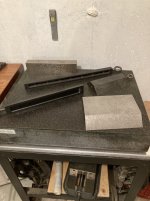Denis, do you have your own heat treat oven now? If yes, what type did you get?
I got a “Foster Featherweight 48"

That is, I made my own oven for annealing and stress relief about a year ago, That saves trips to a heat treater 60 miles away. The actual charges he made were small---it was the time to drop off and a day later pick up that was the problem. My oven is not a full-on heat treat oven capable of going through a complex and rapid up and down cycle like that needed for various high speed steels and the like. It is a simple fabricated steel box insulated with three inches of ceramic wool and heated with a resistance wire coil I wound. The coil is controlled with a very nice Bartlett (made in Iowa) programmable kiln control unit and fairly good-sized relay. It is perfectly suited to my needs as it will accommodate my 48" camel back and my precision 30x12x4" square and anything smaller. I just load it, program the control, and push "Start." It takes a few hours to reach 1150, holds for 1.5 hours, and then shuts itself off. 12 hours after shutoff it has cooled and the part is done. I really like it. I also have a smaller commercial kiln for 18's and 8's (my most popular seller BTW).
To anneal cast iron the part must be wrapped in a SS envelope or placed in a SS cylinder to prevent oxidation. Stress relief causes discoloration, but the temps are low enough that there is no problem with oxidation.
Denis




